TruVelo DS2,
Portable Autovision 2 & Speedmaster.
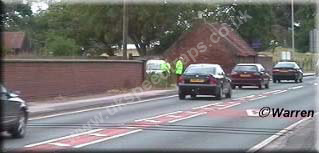
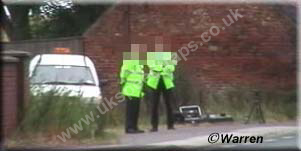
Above: Ford
Escort Van used for the task of hiding the Autovision System,
in this case the system was on the pavement. Note The
orange light on the van not blue,
and from the back of this van it just looked like a breakdown
vehicle,
from the side it has police on it.
DS2 (TruVelo) is a portable attended or unattended
trap using a set of three rubber hoses and at one end are Piezo-electric
Sensors, being either permanent which are hard to spot, or a
moveable system which is easier to spot. Look for the three
strips 1 metre apart on the tarmac, at the permanent sites look
for the small grey pillar about two foot high. These sites can
be linked to Portable Autovision or Autovision 2 allowing the
Police to gather video evidence and sometimes these sites will
be left unattended.
Autovision (See
bottom of page for picture) is the system you see on Police, Camera,
Action for obtaining Video evidence, being a portable video camera
or a fixed camera inside the Police car, they can hock this up
to most speed trap equipment including VASCAR 5000, If connected
to Speedmaster it can nab five vehicles a second.
Speedmaster very much the same as DS2, it is
a portable attended or unattended trap using a set of three rubber
hoses and at one end are Piezo-electric Sensors. Usually sited
in set locations where the local council and Police have decided
to put them, they bury them in the road, and the only give-away
can be a small Grey box by the side of the road or looking for
the three strips. This system can be linked up to Autovision for
video evidence as well.
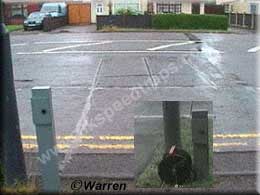
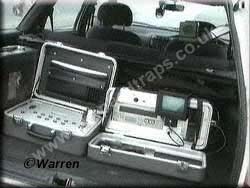
Left: Roadside post and cable real to link up to control unit,
in the background you can see the Piezo Strips
Right: Inside boot are two cases, first one is the speed
measuring equipment,
second one is the video unit, the camera can be seen
just to the side of the rear view mirror.
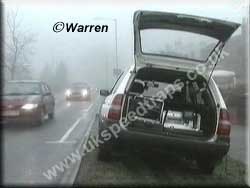
Above: Unmarked
Ford Escort Estate used for
the task of hiding the Autovision System.
How
they Work
The strips or hose are a known
distance apart, and the time between compression's is measured
to give the resulting speed of the vehicle. The system takes two
readings on a two-axle vehicle and uses the average time for compression's
to calculate the resulting speed. Because there are three strips,
it can measure the speed of vehicles travelling in either direction
by comparing which strip was compressed first. Don't mistake these
for the system that the DoT use to do road-usage statistics (counting
the number of vehicles etc.), these units have either one or two
rubber hoses across the road or inductive loops that cross the
hole road.
DS2 (TruVelo) and
Speedmaster 2 systems are usually always accompanied
by Police officers, either in the bushes or sat in a car. One
officer may be in another car or standing up the road talking
to the officer taking the reading by a radio link, he will then
pull over the offending vehicle. The system is very portable and
only tends to be used on two lane roads.
Autovision being the camera based system can be left unattended just like
a Gatso, the camera is usually always sited in an unmarked vehicle.
Autovision is becoming very popular because they can use one system in many
places, the cost of placing the strips in the tarmac is low, compared
to siting a Gatso Camera, and the police can hook up in a few
minutes to the loops via the road side box, they then video offenders
and move on to another site.
Often the roads covered have signs saying "Mobile Speed Cameras"
and these strips are now in a lot of places. Look for the tell
tail Grey Post by the side of the road and the three strips next
to the post, they are quite often sited in a position where a
police car can park safely down from them like a lay-by. They
have been seen on the M1 in Northamptonshire near Jun 16 with
the strips in lane 3 so watch out.
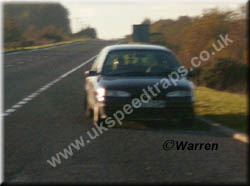
Above: Unmarked
ford in Scotland using pre installed
road strips and a lay-by so as not to stand out




